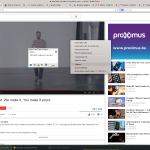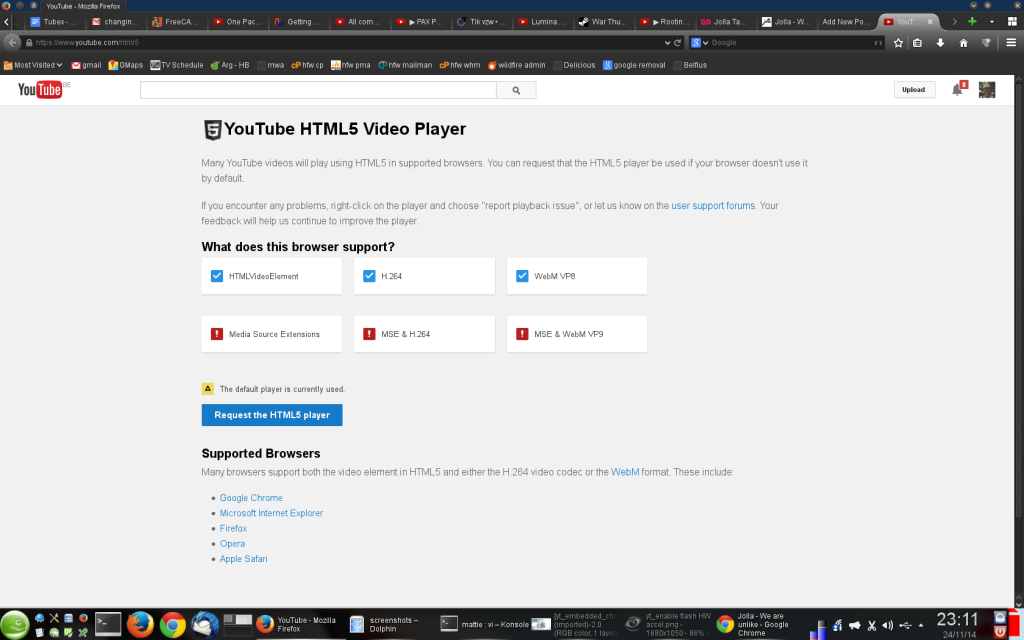Ever since Google Chrome became terribly slow in gmail, drive, etc regardless of computer or platform, I’ve picked up Mozilla Firefox again. The switch didn’t go painless but I really was tired of typing a whole sentence before Chrome would display it. This problem produces itself not only on google sites but actually in about any text box I would type, be it intermittently.
The main issue with switching to Firefox was stuttering video playback. As you may know, chrome bundles its own flash plugin which is actually the same plugin but tweaked to work optimally with chrome (pepper api). At the same time google controls distribution/patching. So, if google can tweak the plugin for good performance, why can’t we? 😉
First thing I discovered, is that somehow flash hardware acceleration was disabled. You can enable this by right-clicking on any flash video and click on “settings”. In the “Display” tab, you can check “Enable Hardware Acceleration”.
 Smooth youtube vids FTW! Fullscreen video’s also showed up on the correct monitor now (dual head setup). My joy was only for limited time, as I discovered hardware acceleration dit not work for embedded youtube video’s. I was happy nevertheless as the bulk of video’s I watch are on youtube.
Smooth youtube vids FTW! Fullscreen video’s also showed up on the correct monitor now (dual head setup). My joy was only for limited time, as I discovered hardware acceleration dit not work for embedded youtube video’s. I was happy nevertheless as the bulk of video’s I watch are on youtube.
However, today, watching the Jolla Tablet intro movie embedded on the site, I could not help feeling the itch again. Why oh why did this play fluently in chrome but did it suck so hard in firefox? Check out this framerate:
 I started by creating a virgin system account to avoid having my 7 year old home dir, possibly dragging along some evil deprecated setting, be the culprit. This didn’t change anything but at least I had both a blank Firefox and Chrome profile to test with.
I started by creating a virgin system account to avoid having my 7 year old home dir, possibly dragging along some evil deprecated setting, be the culprit. This didn’t change anything but at least I had both a blank Firefox and Chrome profile to test with.
First I was under the impression that there would have to be a global flash settings file since when right-clicking on the embedded video, it showed the “Settings” as disabled. There does indeed exist such file: /etc/adobe/mms.cfg in which you can put “EnableLinuxHWVideoDecode=1”. This only crashed my firefox. I did install an additional vdpau package but it didn’t matter. Also, looking at the “Nerd stats” (right-click on video), I learned even youtube vids didn’t have hardware accelerated decoding, only accelerated rendering. So I didn’t proceed on this path.
Now let’s check out how chrome is doing it. Pulling up the “Nerd stats” did surprise me: chrome does not use flash by default for embedded video’s, it uses WebM/VP9!
 This begs the question: how is Firefox’s WebM support? Turns out it’s no problem, just change your youtube html5 setting from “default player” (=flash) to “html5”.
This begs the question: how is Firefox’s WebM support? Turns out it’s no problem, just change your youtube html5 setting from “default player” (=flash) to “html5”.
 So the chrome pepper flash tweak actually came down on not using flash. 🙂 Youtube does this by default on chrome but not on firefox. Naughty Google!
So the chrome pepper flash tweak actually came down on not using flash. 🙂 Youtube does this by default on chrome but not on firefox. Naughty Google!
You may notice that Firefox does not support all youtube hmtl5 features yet. In particular, you will be served VP8 video’s instead of VP9 which may make a difference in the available resolutions. However, Media Source Extensions and WebM VP9 can already be activated by setting:
media.mediasource.enabled = true
in about:config. Experimental h264 support can be activated with:
media.mediasource.ignore_codecs = true
You can track the MSE support in firefox in this bug report.
Itch scratched and fixed. Finally 🙂